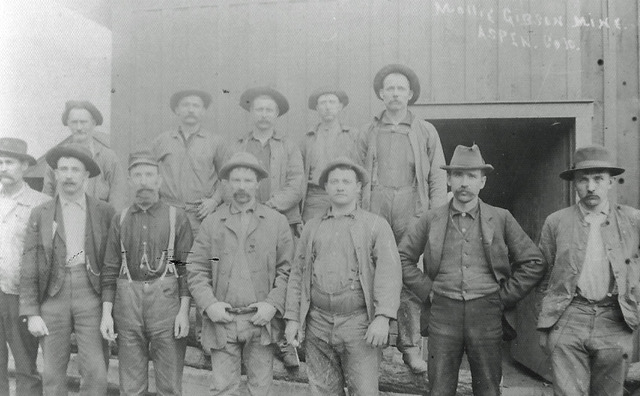Willoughby: Fedora hats – Aspen mirrors its history

Willoughby Collection/Courtesy photo
My father, like many of his generation, wore a hat anytime he was outside.
He didn’t do it because, like for me, a doctor told him that high altitude sun on a mostly bald head could lead to skin cancer. For him, it was just what men did at that time, and his choice of a hat, Fedora, was also for fashion reasons, not practicality. It could also have been because his father favored them.
Like my father, most miners wore hats much of their day, including underground. Even into the 1930s, they wore soft hats, not hard hats. Like in the photo here, you often will see at least one miner with a Fedora on. Older photos of Aspen men dressed for an occasion are wearing hats, and again, you often see one or two with Fedoras.
The history of Fedora hats is interesting, and it mostly coincides with Aspen’s history. The name comes from the character in a play, “Princess Fédora Romanoff.” The play, written by Victorien Sardou, featured Sarah Bernhardt in that role in 1891.
An 1891 Aspen Times piece about her titled, “How Bernhardt Dresses,” mentions her hat choice that became standard for Fedora hats. Fedoras became popular for women at that time due to the popularity of Bernhardt.
Wikipedia, in chronicling those early years, states that Fedoras became popular for men in 1924 when Edward, Prince of Wales, began wearing them. Aspen was ahead of that trend because men were buying Fedoras at the same time they were popular with women. The first ad for them was in 1892 from The Famous – T.J. Lynch and Company, an Aspen clothing store on Galena Street. It advertised “the latest Fedora, all colors” for $3.50 ($94 in today’s dollars).
Kobey’s began advertising Fedoras in 1894 at about half the price of The Famous, and a year later, The Famous lowered its price by two thirds. Another clothing company, C.F. Young, sold them as well.
Kobey’s was the only dealer advertising Fedoras beginning in 1897. One ad said they had Stetsons that were stiff and Fedoras with soft shapes. At the turn of the century, they had a sale on for Fedoras in pearl color with black trimmings.
The hat was a common product after that, and Kobey’s the only dealer. In 1915, they sold for $2.00 ($8 in today’s dollars). Kobey’s began selling straw hats in the Fedora style beginning in 1924 and, later, Fedora-“shaped” Panama hats in 1927.
The Isis theater showed the movie “Fedora” in 1918. It was a silent movie of the original play. The star was Pauline Frederik, a star of the silent-movie period, who enjoyed doing stage productions. She was in 63 films and has a star in the Hollywood Walk of Fame.
Jumping back to the beginning in my parent’s time, I remember a story my mother told me about when she worked at Kobey’s, beginning just before the Depression. Sales slumped quickly after the crash, and Kobey’s was stuck with merchandise. It had a basement that was not open to customers, was used only for storage. Mother had a very strong memory of piles of unsold hats in the basement; when she told me the story, she said, “Stetson hats,” so I will make a large leap and suggest that Fedoras were the major men’s hat sales.
Tim Willoughby’s family story parallels Aspen’s. He began sharing folklore while teaching at Aspen Country Day School and Colorado Mountain College. Now a tourist in his native town, he views it with historical perspective. Reach him at redmtn2@comcast.net








